18th century
Belonging to Jean de Lignareix de Bonnefond in the middle of the 18th century, this property was first passed on by women.
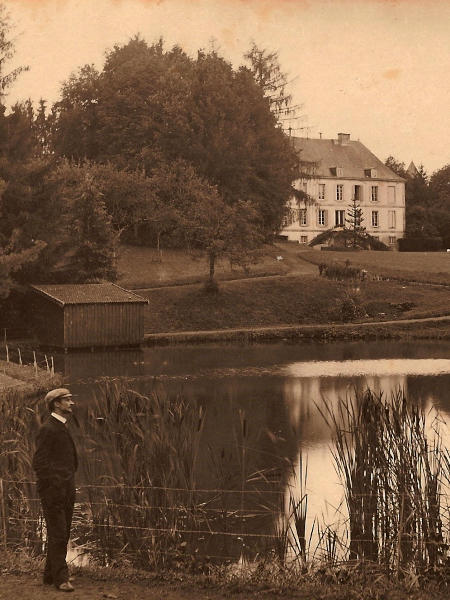
19th century
In 1808, Jean de Lignareix de Bonnefond’s granddaughter, Marie-Jeanne du Giraudeix, through her marriage to Jean-Jacques d’Ussel, brought the estate into the Ussel family where it has remained ever since. There is no trace of the old castle after its disappearance in the fire of 1822. To know more about it.
The current residence was rebuilt in 1830, in the Restoration style. The building site lasted 4 years and was commissioned by Jean-Hyacinthe d’Ussel, 21 years old, who made the plans. He later became mayor of Neuvic and founded the « Ferme-Ecole des Plaines » in the village, which opened in 1850 and operated until the 1914 war. He was also the precursor of the introduction of “green trees”, the name given to the resinous trees at that time. As soon as the house was completed, Jean-Hyacinthe began to create the park, giving it the dual vocation of a landscaped agricultural park and an arboretum, which was fashionable at the time. Cows for milk and calves as well as horses and donkeys for the carriages shared the pastures. Fish were caught in the pond. Near the house were: stable, pigsty, barnyard. A vegetable garden and an orchard produced vegetables and fruits for the family and the domesticity. At night, the master of the house would sit in the “cantou” (a large fireplace) and tell stories to the whole household. We lived here in autarky.
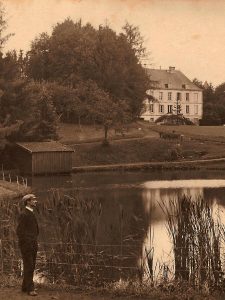
19th century
In 1808, Jean de Lignareix de Bonnefond’s granddaughter, Marie-Jeanne du Giraudeix, through her marriage to Jean-Jacques d’Ussel, brought the estate into the Ussel family where it has remained ever since. There is no trace of the old castle after its disappearance in the fire of 1822. To know more about it.
The current residence was rebuilt in 1830, in the Restoration style. The building site lasted 4 years and was commissioned by Jean-Hyacinthe d’Ussel, 21 years old, who made the plans. He later became mayor of Neuvic and founded the « Ferme-Ecole des Plaines » in the village, which opened in 1850 and operated until the 1914 war. He was also the precursor of the introduction of “green trees”, the name given to the resinous trees at that time. As soon as the house was completed, Jean-Hyacinthe began to create the park, giving it the dual vocation of a landscaped agricultural park and an arboretum, which was fashionable at the time. Cows for milk and calves as well as horses and donkeys for the carriages shared the pastures. Fish were caught in the pond. Near the house were: stable, pigsty, barnyard. A vegetable garden and an orchard produced vegetables and fruits for the family and the domesticity. At night, the master of the house would sit in the “cantou” (a large fireplace) and tell stories to the whole household. We lived here in autarky.
20th century
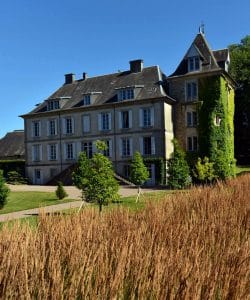
Successive generations added new constructions and plantations. In 1922, Jacques d’Ussel built the tower to bring the comfort of the 20th century and arranged rooms in the attic for his numerous children. As early as 1946, Patrick d’Ussel’s mother planted trees to replace those that were missing, and he did so himself in 1965. The latter introduced a wide variety of species to renew the arboretum. Damaged by two storms, 1982 and 1999, many beautiful specimens fell. Others had to be felled, including one of the first Douglas introduced in Corrèze dating from 1845, with a volume of 33m3! Fortunately, there are still many old trees, many of them remarkable. The cows gave way to some sheep, they animated the meadows until 2009.
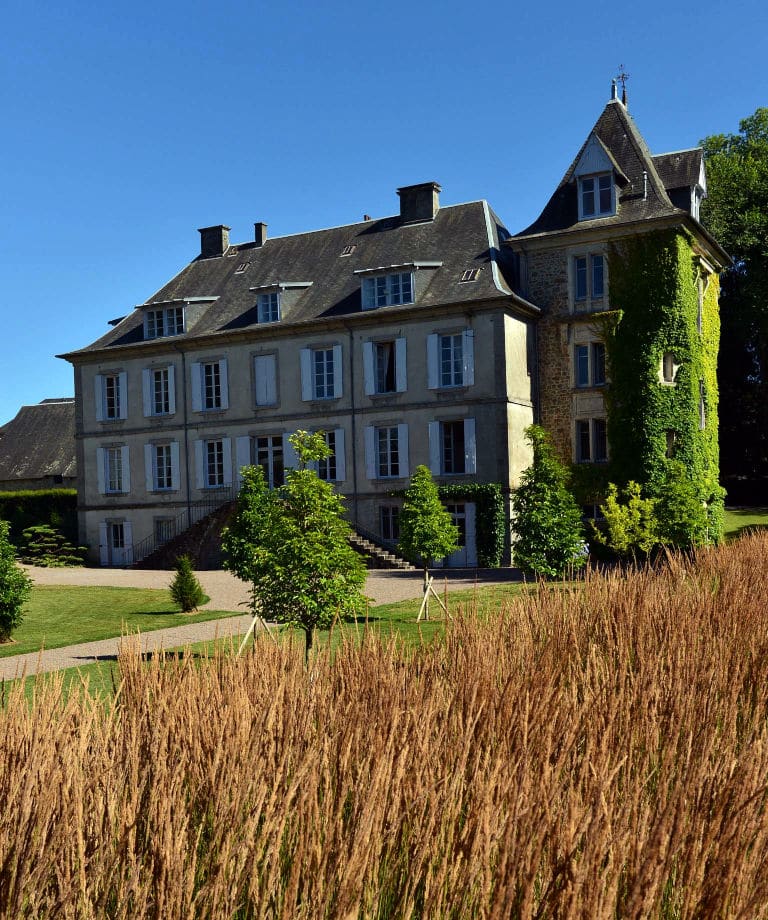
20th century
Successive generations added new constructions and plantations. In 1922, Jacques d’Ussel built the tower to bring the comfort of the 20th century and arranged rooms in the attic for his numerous children. As early as 1946, Patrick d’Ussel’s mother planted trees to replace those that were missing, and he did so himself in 1965. The latter introduced a wide variety of species to renew the arboretum. Damaged by two storms, 1982 and 1999, many beautiful specimens fell. Others had to be felled, including one of the first Douglas introduced in Corrèze dating from 1845, with a volume of 33m3! Fortunately, there are still many old trees, many of them remarkable. The cows gave way to some sheep, they animated the meadows until 2009.
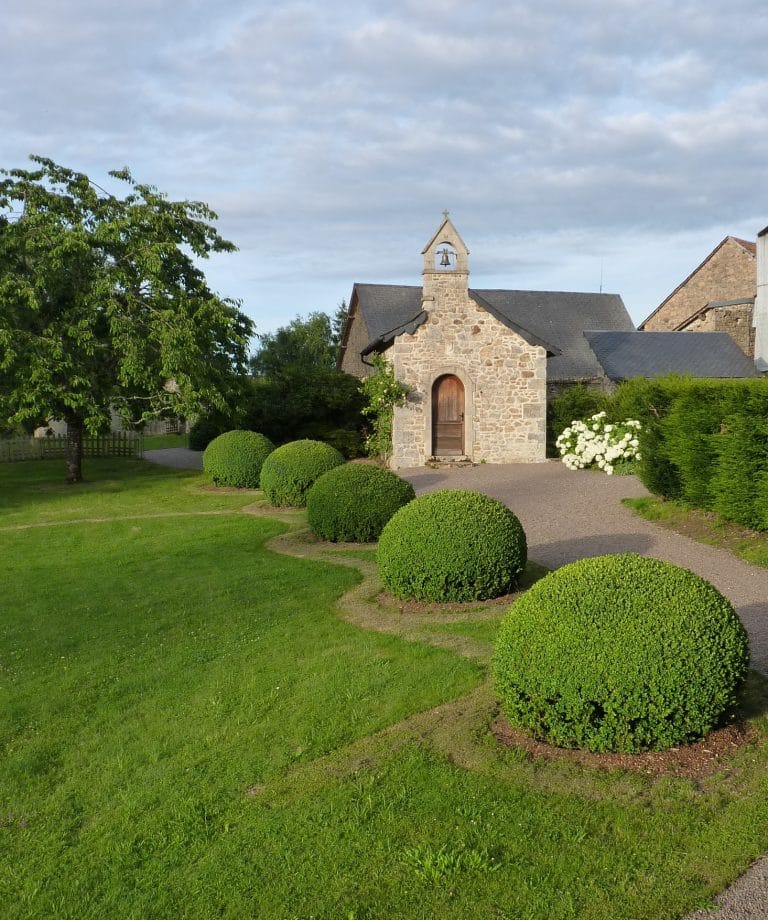
21th century
In 2003, Patrick and Béatrix d’Ussel transformed the unused pigsty into a chapel dedicated to Saint Guillaume, the first name of Patrick’s father and emblematic in the family since its origin.
2007-2021
Thanks to two five-year management plans, the park has been rehabilitated, first under the guidance of Laurent Berthelier, landscape designer, and then by the owner, in order to give it back all the characteristics and charm of its original creation and to improve its botanical diversity.
Alleys were opened again according to the old plan. Badly placed trees were removed to recover the perspectives they had blurred. Each year new species were introduced as well as summer flowering shrubs to improve the visit: the spiral that surrounded the mound was replanted as a triple boxwood crown.
The chestnut wood kiosk located on the rotunda at the highest point of the park (634 m) was rebuilt.
An oratory dedicated to St. Anne erected in a clearing at the bottom of the park, aparish priest’s garden and an orchard have also been created in the spirit of the 19th century.
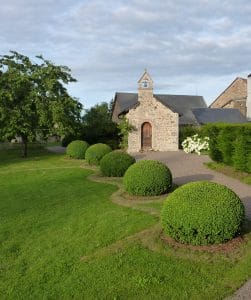
21th century
In 2003, Patrick and Béatrix d’Ussel transformed the unused pigsty into a chapel dedicated to Saint Guillaume, the first name of Patrick’s father and emblematic in the family since its origin.
2007-2021
Thanks to two five-year management plans, the park has been rehabilitated, first under the guidance of Laurent Berthelier, landscape designer, and then by the owner, in order to give it back all the characteristics and charm of its original creation and to improve its botanical diversity.
Alleys were opened again according to the old plan. Badly placed trees were removed to recover the perspectives they had blurred. Each year new species were introduced as well as summer flowering shrubs to improve the visit: the spiral that surrounded the mound was replanted as a triple boxwood crown.
The chestnut wood kiosk located on the rotunda at the highest point of the park (634 m) was rebuilt.
An oratory dedicated to St. Anne erected in a clearing at the bottom of the park, aparish priest’s garden and an orchard have also been created in the spirit of the 19th century.
Belonging to Jean de Lignareix de Bonnefond in the middle of the 18th century, this property was first passed on by women.
In 1808, Jean de Lignareix de Bonnefond’s granddaughter, Marie-Jeanne du Giraudeix, through her marriage to Jean-Jacques d’Ussel, brought the estate into the Ussel family where it has remained ever since. There is no trace of the old castle after its disappearance in the fire of 1822. To know more about it.
The current residence was rebuilt in 1830, in the Restoration style. The building site lasted 4 years and was commissioned by Jean-Hyacinthe d’Ussel, 21 years old, who made the plans. He later became mayor of Neuvic and founded the « Ferme-Ecole des Plaines » in the village, which opened in 1850 and operated until the 1914 war. He was also the precursor of the introduction of “green trees”, the name given to the resinous trees at that time. As soon as the house was completed, Jean-Hyacinthe began to create the park, giving it the dual vocation of a landscaped agricultural park and an arboretum, which was fashionable at the time. Cows for milk and calves as well as horses and donkeys for the carriages shared the pastures. Fish were caught in the pond. Near the house were: stable, pigsty, barnyard. A vegetable garden and an orchard produced vegetables and fruits for the family and the domesticity. At night, the master of the house would sit in the “cantou” (a large fireplace) and tell stories to the whole household. We lived here in autarky.
Successive generations added new constructions and plantations. In 1922, Jacques d’Ussel built the tower to bring the comfort of the 20th century and arranged rooms in the attic for his numerous children. As early as 1946, Patrick d’Ussel’s mother planted trees to replace those that were missing, and he did so himself in 1965. The latter introduced a wide variety of species to renew the arboretum. Damaged by two storms, 1982 and 1999, many beautiful specimens fell. Others had to be felled, including one of the first Douglas introduced in Corrèze dating from 1845, with a volume of 33m3! Fortunately, there are still many old trees, many of them remarkable. The cows gave way to some sheep, they animated the meadows until 2009.
In 2003, Patrick and Béatrix d’Ussel transformed the unused pigsty into a chapel dedicated to Saint Guillaume, the first name of Patrick’s father and emblematic in the family since its origin.
2007-2021
Thanks to two five-year management plans, the park has been rehabilitated, first under the guidance of Laurent Berthelier, landscape designer, and then by the owner, in order to give it back all the characteristics and charm of its original creation and to improve its botanical diversity.
Alleys were opened again according to the old plan. Badly placed trees were removed to recover the perspectives they had blurred. Each year new species were introduced as well as summer flowering shrubs to improve the visit: the spiral that surrounded the mound was replanted as a triple boxwood crown.
The chestnut wood kiosk located on the rotunda at the highest point of the park (634 m) was rebuilt.
An oratory dedicated to St. Anne erected in a clearing at the bottom of the park, aparish priest’s garden and an orchard have also been created in the spirit of the 19th century.
